Eddy Current-Based Delamination Imaging in CFRP Using Erosion and Thresholding Approaches
Abstract
:1. Introduction
2. ECT Inspection Process and Setup
2.1. Characteristics of the Specimens under Test
2.2. ECT Probe
2.3. Experimental Setup and Procedures Used for the ECT Inspection
3. Methodology for Imaging and Estimating Delamination Size
4. C-Scan Images of the ECT Data
5. Erosion Method for ECT Data
6. Thresholding Approaches for Damage Evaluation
7. Delamination Imaging and Sizing
8. Conclusions
Author Contributions
Funding
Institutional Review Board Statement
Informed Consent Statement
Data Availability Statement
Acknowledgments
Conflicts of Interest
References
- Hegde, S.; Satish Shenoy, B.; Chethan, K.N. Review on Carbon Fiber Reinforced Polymer (CFRP) and Their Mechanical Performance. Mater. Today Proc. 2019, 19, 658–662. [Google Scholar] [CrossRef]
- Maurya, M.; Sadarang, J.; Panigrahi, I.; Dash, D. Detection of Delamination in Carbon Fibre Reinforced Composite Using Vibration Analysis and Artificial Neural Network. Mater. Today Proc. 2022, 49, 517–522. [Google Scholar] [CrossRef]
- Jiang, P.; Liu, X.; Li, W.; Guo, F.; Hong, C.; Liu, Y.; Yang, C. Damage Characterization of Carbon Fiber Composite Pressure Vessels Based on Modal Acoustic Emission. Materials 2022, 15, 4783. [Google Scholar] [CrossRef] [PubMed]
- Saeedifar, M.; Zarouchas, D. Damage Characterization of Laminated Composites Using Acoustic Emission: A Review. Compos. Part B Eng. 2020, 195, 108039. [Google Scholar] [CrossRef]
- Caminero, M.A.; García-Moreno, I.; Rodríguez, G.P.; Chacón, J.M. Internal Damage Evaluation of Composite Structures Using Phased Array Ultrasonic Technique: Impact Damage Assessment in CFRP and 3D Printed Reinforced Composites. Compos. Part B Eng. 2019, 165, 131–142. [Google Scholar] [CrossRef]
- Feng, B.; Ribeiro, A.L.; Ramos, H.G. A New Method to Detect Delamination in Composites Using Chirp-Excited Lamb Wave and Wavelet Analysis. NDT E Int. 2018, 100, 64–73. [Google Scholar] [CrossRef]
- Dua, G.; Mulaveesala, R.; Kher, V.; Rani, A. Gaussian Windowed Frequency Modulated Thermal Wave Imaging for Non-Destructive Testing and Evaluation of Carbon Fibre Reinforced Polymers. Infrared Phys. Technol. 2019, 98, 125–131. [Google Scholar] [CrossRef]
- Wang, T.; Wu, D.; Chen, W.; Yang, J. Detection of Delamination Defects inside Carbon Fiber Reinforced Plastic Laminates by Measuring Eddy-Current Loss. Compos. Struct. 2021, 268, 114012. [Google Scholar] [CrossRef]
- Rao, B.P.C. Practical Eddy Current Testing; Alpha Science International Ltd.: Oxford, UK, 2007. [Google Scholar]
- Zhou, Y.; Ye, B.; Cao, H.; Zou, Y.; Zhu, Z.; Xing, H. High-Sensitivity Detection of Carbon Fiber-Reinforced Polymer Delamination Using a Novel Eddy Current Probe. Appl. Sci. 2024, 14, 3765. [Google Scholar] [CrossRef]
- Pasadas, D.J.; Barzegar, M.; Ribeiro, A.L.; Ramos, H.G. Locating and Imaging Fiber Breaks in CFRP Using Guided Wave Tomography and Eddy Current Testing. Sensors 2022, 22, 7377. [Google Scholar] [CrossRef]
- Wu, D.; Cheng, F.; Yang, F.; Huang, C. Non-Destructive Testing for Carbon-Fiber-Reinforced Plastic (CFRP) Using a Novel Eddy Current Probe. Compos. Part B Eng. 2019, 177, 107460. [Google Scholar] [CrossRef]
- Pasadas, D.J.; Ramos, H.G.; Baskaran, P.; Ribeiro, A.L. ECT in Composite Materials Using Double Excitation Coils and Resonant Excitation/Sensing Circuits. Measurement 2020, 161, 107859. [Google Scholar] [CrossRef]
- Machado, M.A.; Antin, K.-N.; Rosado, L.S.; Vilaça, P.; Santos, T.G. High-Speed Inspection of Delamination Defects in Unidirectional CFRP by Non-Contact Eddy Current Testing. Compos. Part B Eng. 2021, 224, 109167. [Google Scholar] [CrossRef]
- Nguyen, H.-T.; Jeng, J.-T.; Doan, V.-D.; Dinh, C.-H.; Dao, D.V.; Pham, T.-T.; Trinh, X.-T. Surface and Subsurface Eddy-Current Imaging with GMR Sensor. IEEE Trans. Instrum. Meas. 2021, 70, 6011310. [Google Scholar] [CrossRef]
- Xie, L.; Baskaran, P.; Ribeiro, A.L.; Alegria, F.C.; Ramos, H.G. Classification of Corrosion Severity in SPCC Steels Using Eddy Current Testing and Supervised Machine Learning Models. Sensors 2024, 24, 2259. [Google Scholar] [CrossRef] [PubMed]
- Ma, M.; Liu, S.; Zhang, R.; Zhang, Q.; Wu, Y.; Chen, B. Non-Destructive Testing of Carbon Fiber-Reinforced Plastics (CFRPs) Using a Resonant Eddy Current Sensor. Sensors 2024, 24, 3449. [Google Scholar] [CrossRef]
- Łukaszuk, R.; Chady, T. Nondestructive Examination of Carbon Fiber-Reinforced Composites Using the Eddy Current Method. Materials 2023, 16, 506. [Google Scholar] [CrossRef]
- Bernieri, A.; Betta, G.; Ferrigno, L.; Laracca, M.; Mastrostefano, S. Multifrequency Excitation and Support Vector Machine Regressor for ECT Defect Characterization. IEEE Trans. Instrum. Meas. 2014, 63, 1272–1280. [Google Scholar] [CrossRef]
- Smetana, M.; Gombarska, D.; Psenakova, Z. Progress in Evaluation of Deep Artificial Defects from Sweep-Frequency Eddy-Current Testing Signals. Sensors 2023, 23, 6085. [Google Scholar] [CrossRef]
- Mizukami, K.; Hioki, S.; Moriyama, K.; Ogi, K.; Miyaji, W.; Kimura, K. Eddy-Current Array-Probe Technique for Imaging near-Surface and Deep-Lying Delaminations in Multidirectional Carbon Fiber Composites. Compos. Struct. 2021, 276, 114537. [Google Scholar] [CrossRef]
- Hughes, R.R.; Dixon, S. Performance analysis of single-frequency near Electrical Resonance Signal Enhancement (SF-NERSE) defect detection. NDT E Int. 2019, 102, 96–103. [Google Scholar] [CrossRef]

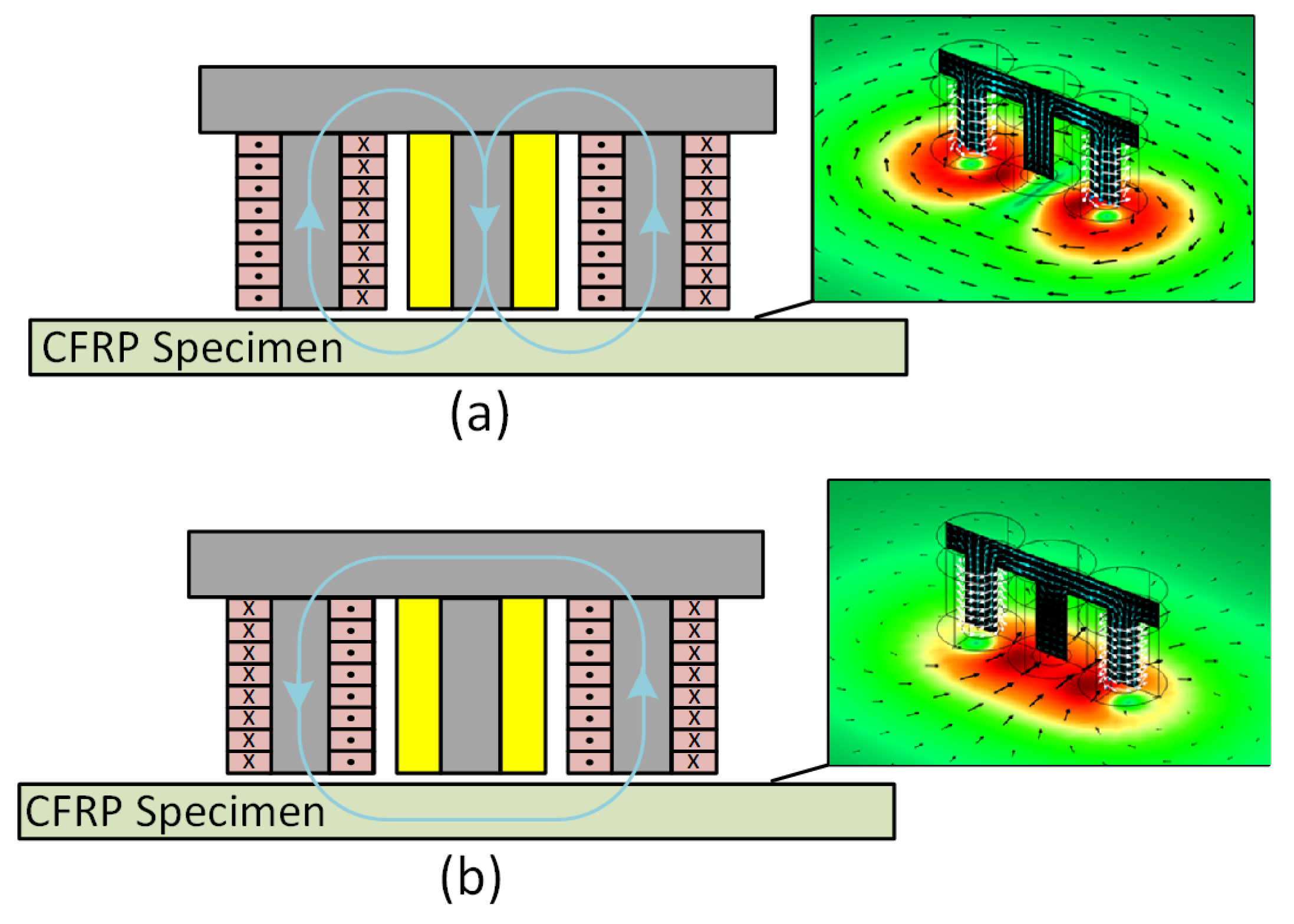



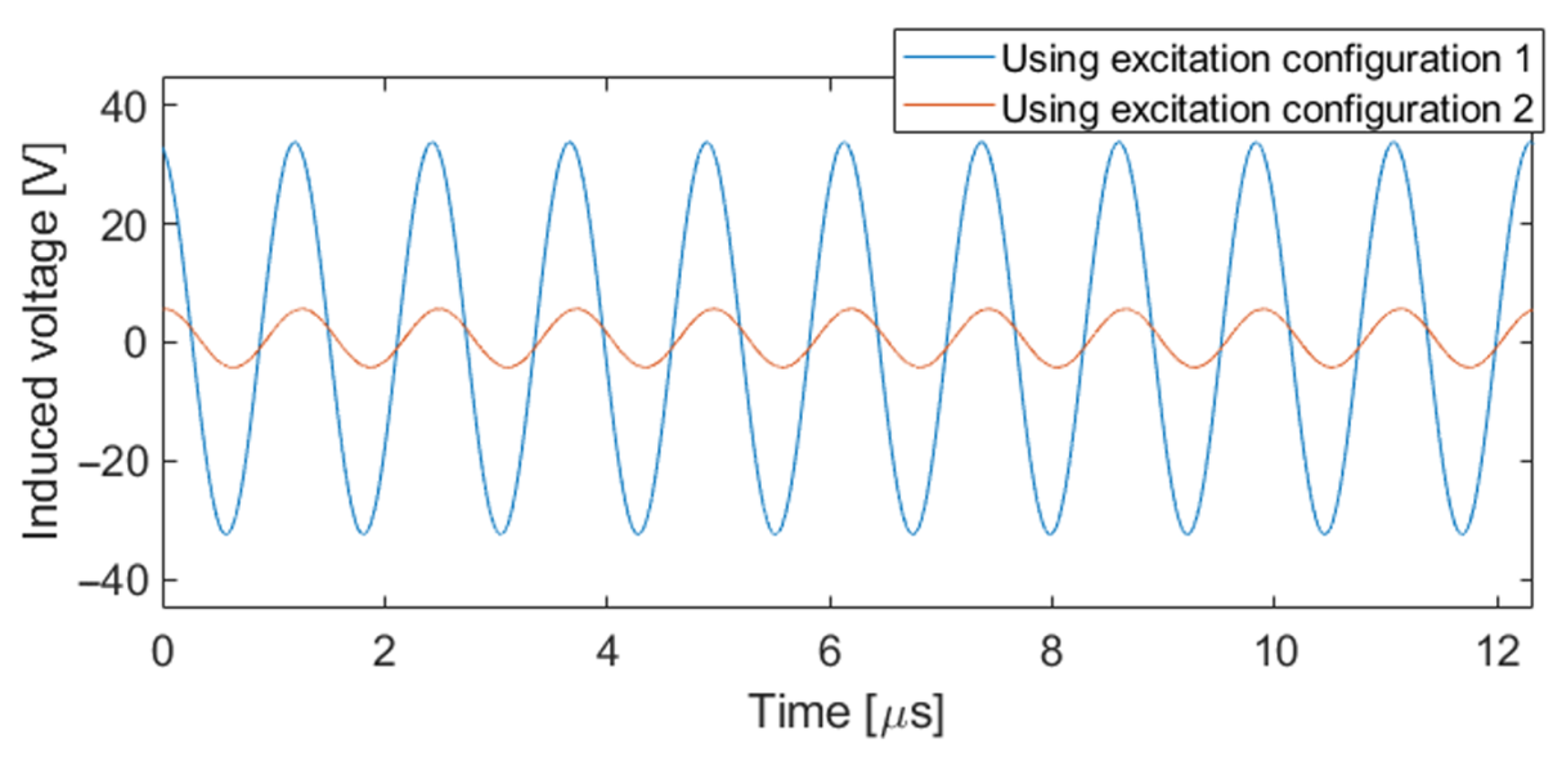

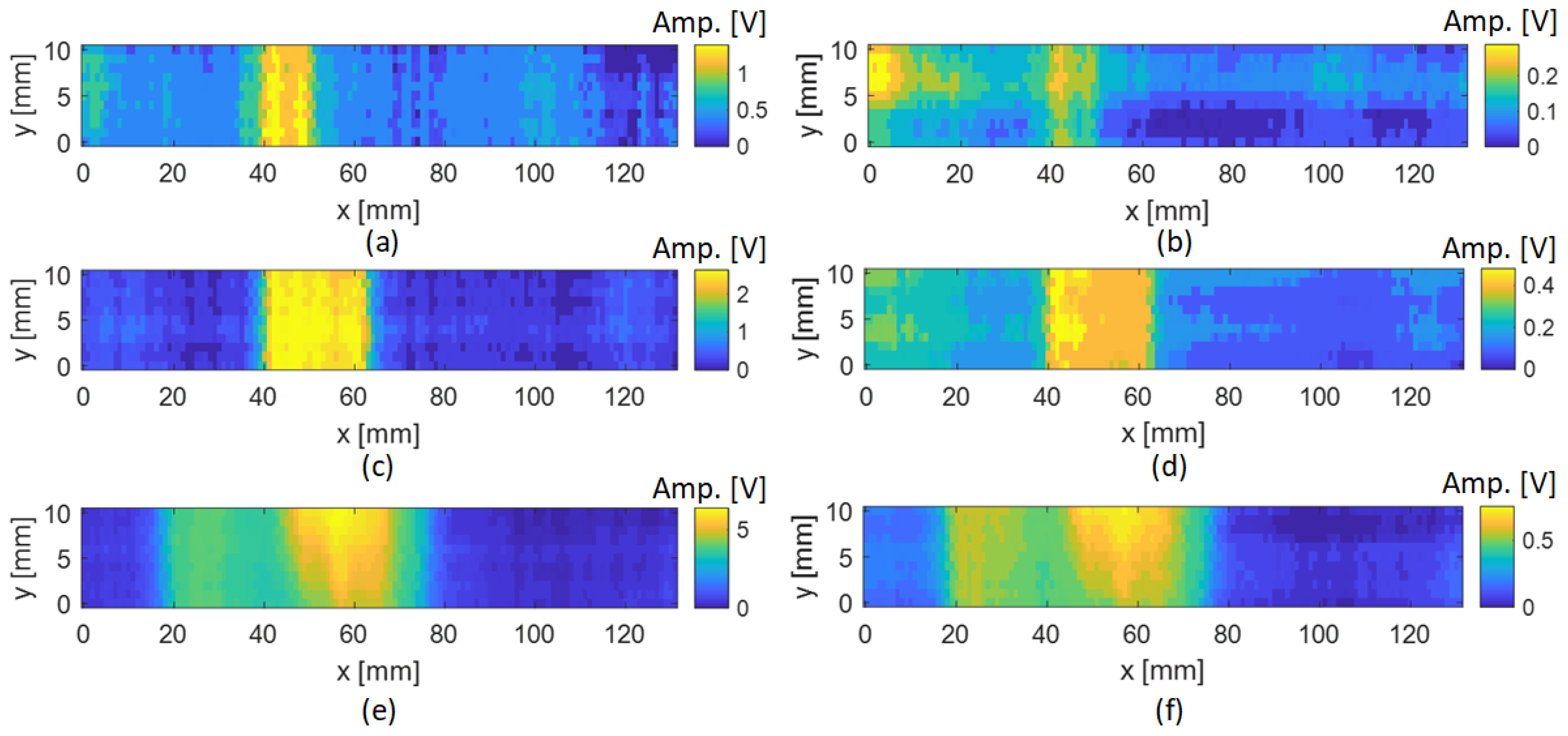


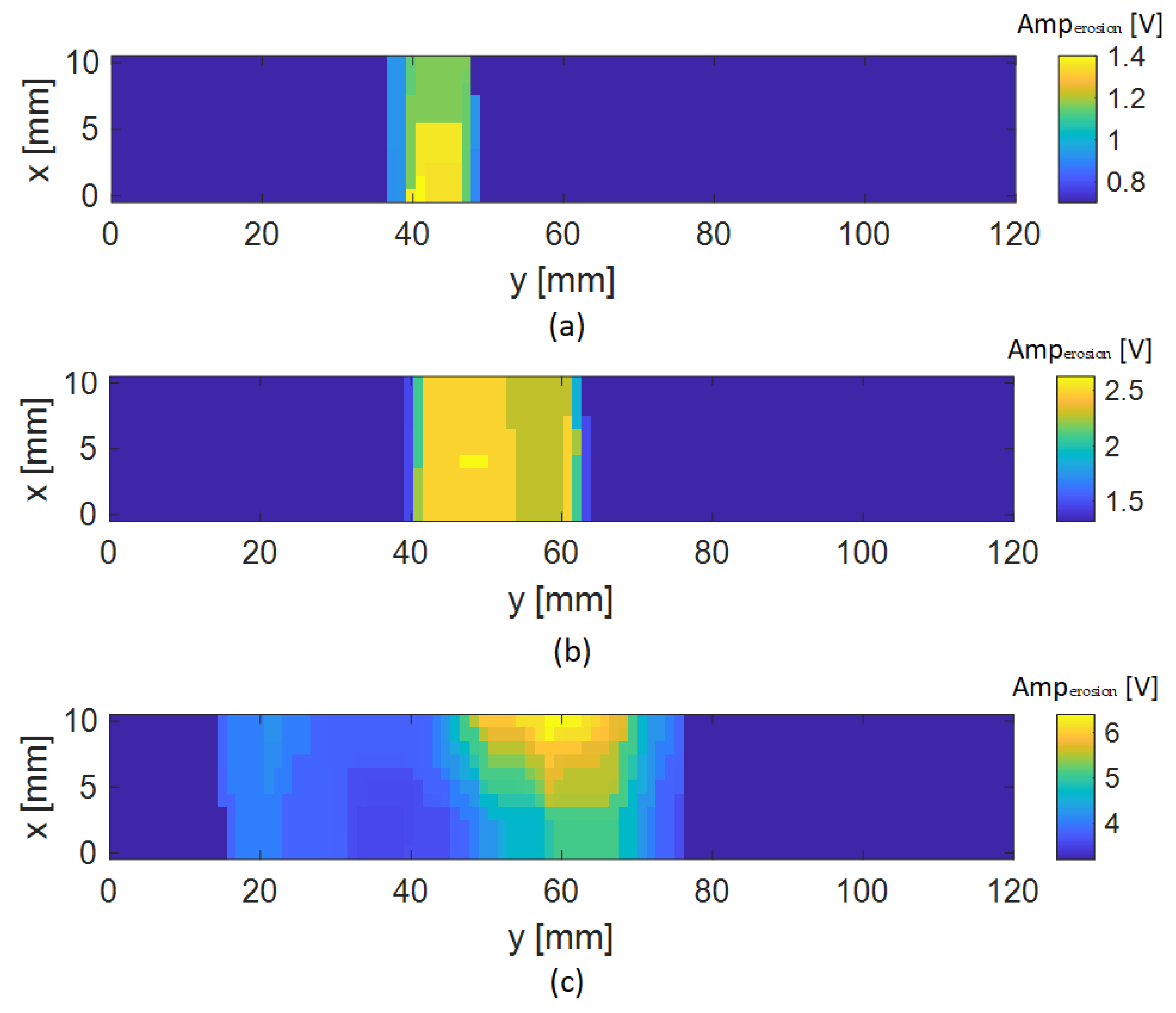
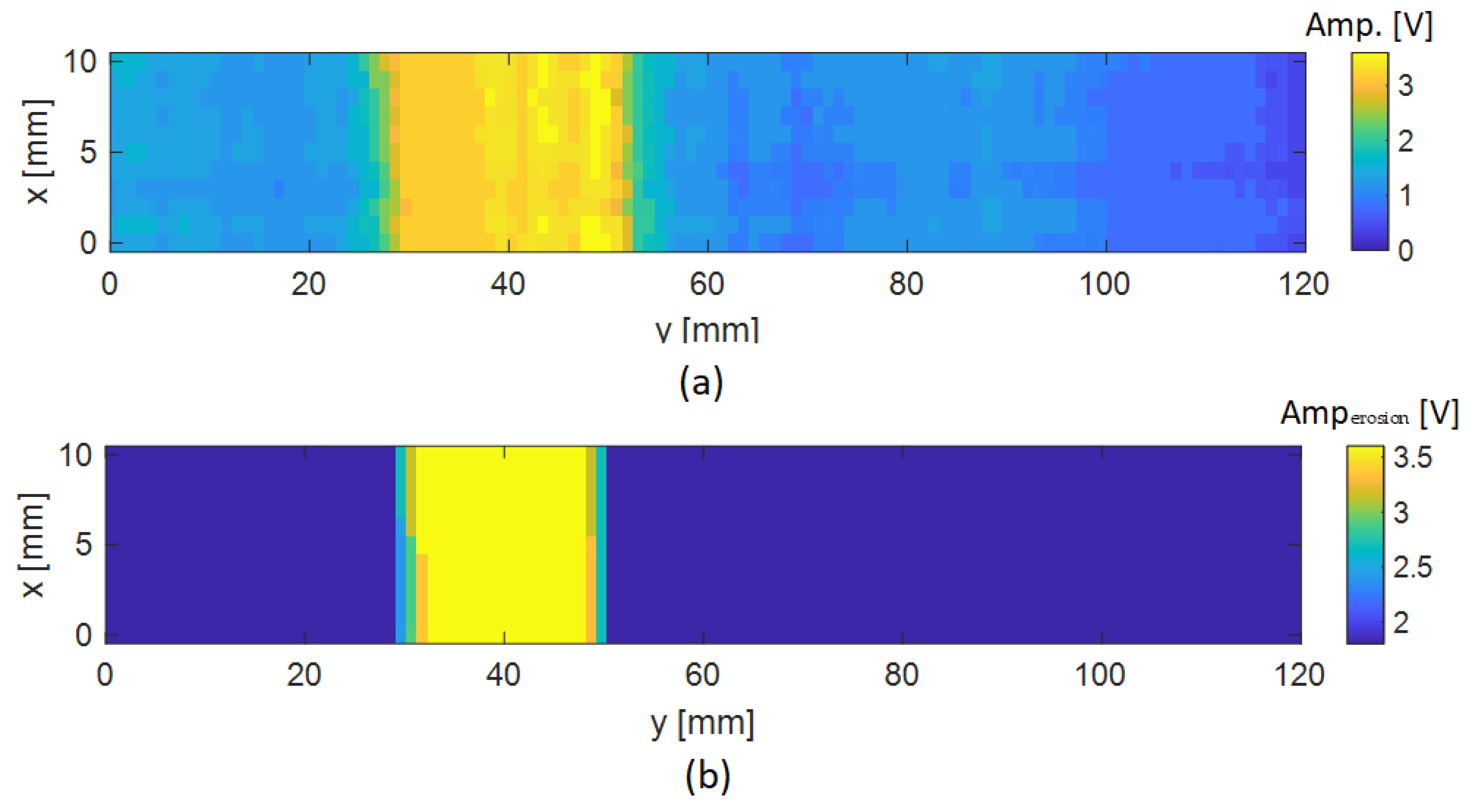
| Approx. Length of the Delamination [mm] | Only Threshold | Erosion→Threshold | Threshold→Erosion | ||||||
|---|---|---|---|---|---|---|---|---|---|
| −3 dB | −6 dB | Otsu’s | −3 dB | −6 dB | Otsu’s | −3 dB | −6 dB | Otsu’s | |
| 5 | 11.00 | 16.18 | 16.18 | 7.00 | 9.73 | 67.27 | 5.91 | 9.73 | 9.73 |
| 20 | 22.18 | 24.45 | 24.45 | 18.00 | 19.73 | 20.00 | 17.64 | 19.73 | 19.73 |
| 50 | 20.09 | 54.36 | 57.64 | 17.27 | 51.18 | 54.45 | 13.91 | 49.64 | 53.00 |
Disclaimer/Publisher’s Note: The statements, opinions and data contained in all publications are solely those of the individual author(s) and contributor(s) and not of MDPI and/or the editor(s). MDPI and/or the editor(s) disclaim responsibility for any injury to people or property resulting from any ideas, methods, instructions or products referred to in the content. |
© 2024 by the authors. Licensee MDPI, Basel, Switzerland. This article is an open access article distributed under the terms and conditions of the Creative Commons Attribution (CC BY) license (https://creativecommons.org/licenses/by/4.0/).
Share and Cite
Pasadas, D.J.; Barzegar, M.; Ribeiro, A.L.; Ramos, H.G. Eddy Current-Based Delamination Imaging in CFRP Using Erosion and Thresholding Approaches. Sensors 2024, 24, 5932. https://doi.org/10.3390/s24185932
Pasadas DJ, Barzegar M, Ribeiro AL, Ramos HG. Eddy Current-Based Delamination Imaging in CFRP Using Erosion and Thresholding Approaches. Sensors. 2024; 24(18):5932. https://doi.org/10.3390/s24185932
Chicago/Turabian StylePasadas, Dario J., Mohsen Barzegar, Artur L. Ribeiro, and Helena G. Ramos. 2024. "Eddy Current-Based Delamination Imaging in CFRP Using Erosion and Thresholding Approaches" Sensors 24, no. 18: 5932. https://doi.org/10.3390/s24185932






